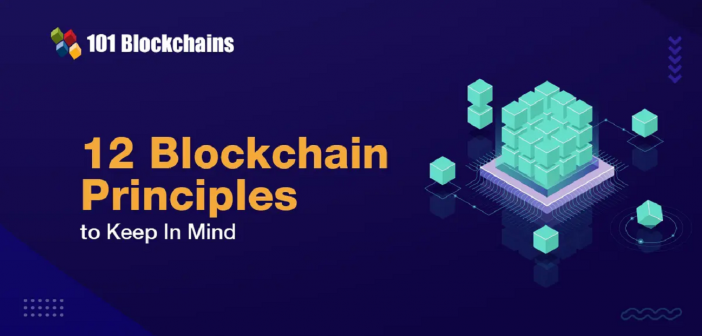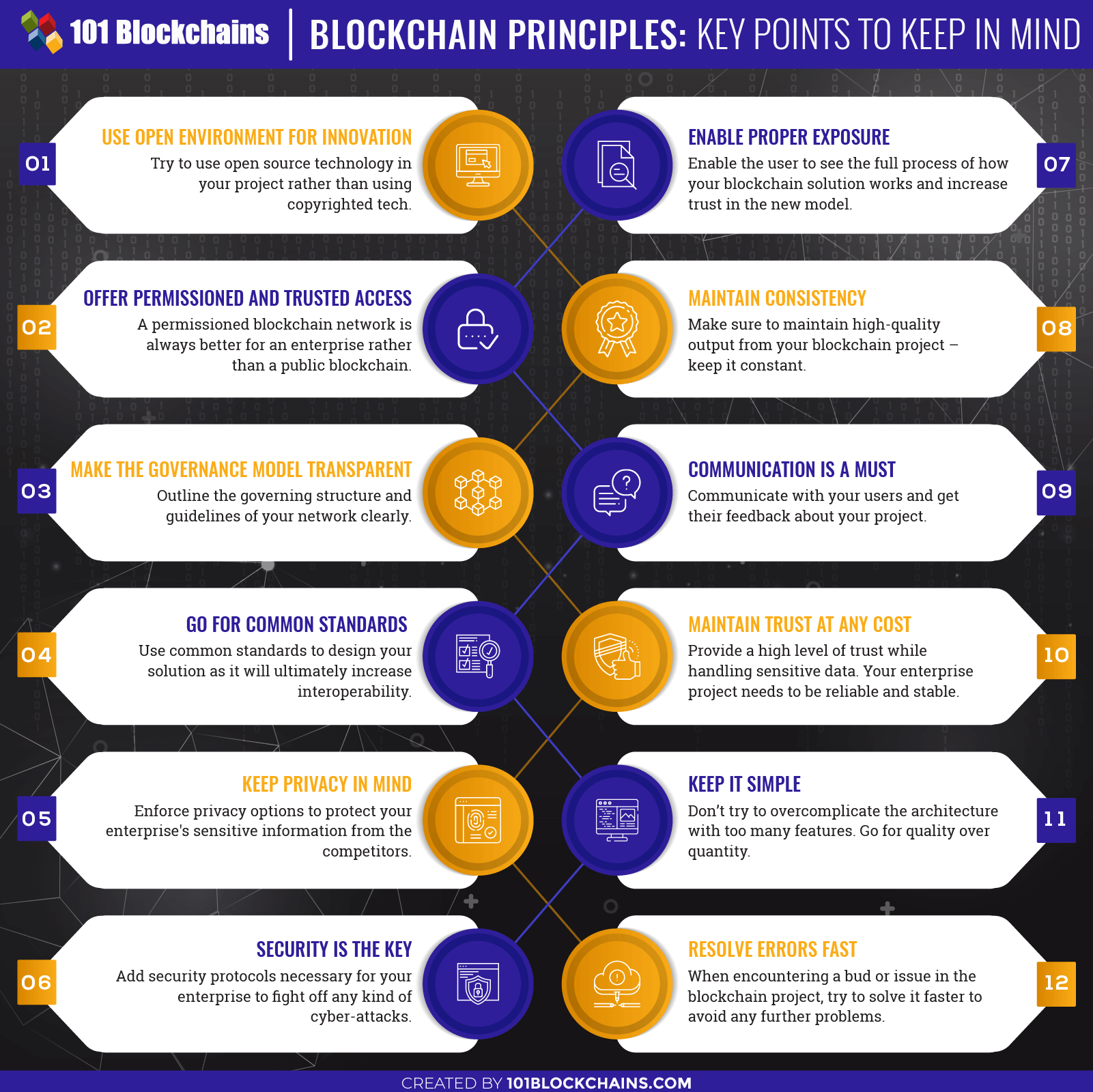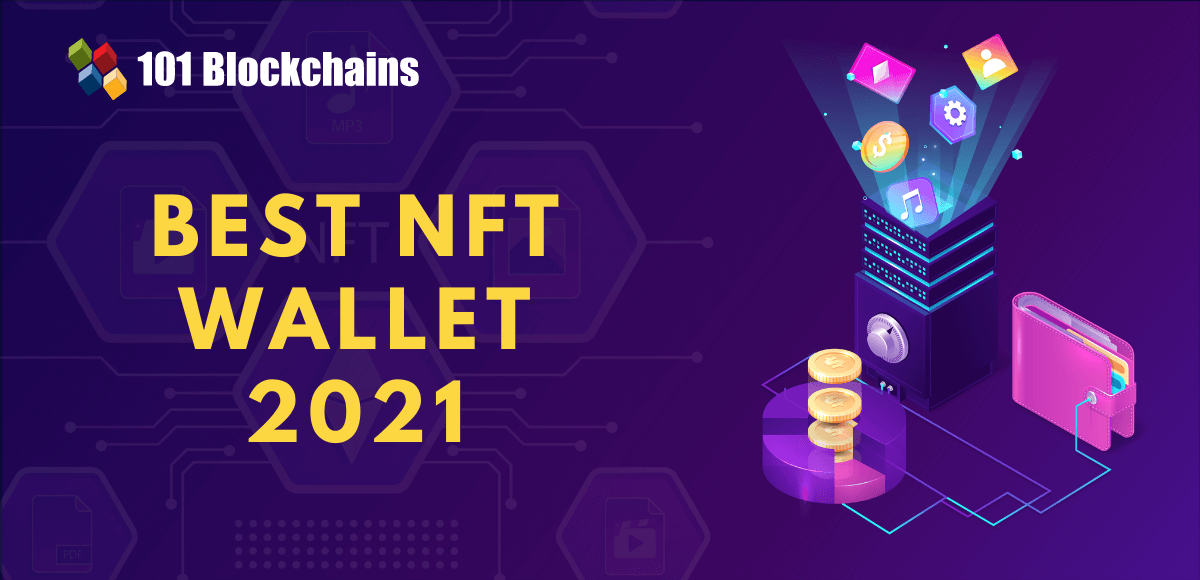Learn how blockchain truly works, master key definitions, and uncover what makes smart contracts so "smart." Dive into the fundamentals, gain valuable insights, and start your blockchain journey today!

- Reviews
Hasib Anwar
- on August 15, 2021
Blockchain Principles: Design Your Enterprise Blockchain
Blockchain innovations are blooming in the tech industry for quite some time now. With the new marketplace in mind, many enterprises are going different directions to design their blockchain for enterprise solutions. Obviously, while designing, you should consider your enterprises’ needs in mind.
However, there are some certain blockchain principles in design that you need to follow. These design blockchain principles are what the major players in the industry are following. To help you out in the designing phase, we are prioritizing specific design principles.
Build your identity as a certified blockchain expert with 101 Blockchains’ Blockchain Certifications designed to provide enhanced career prospects.
So, let’s check out what these blockchain principles are!
Blockchain Principles: 12 Principles to Keep In Mind
Please include attribution to 101blockchains.com with this graphic. <a href='https://101blockchains.com/blockchain-infographics/'> <img src='https://101blockchains.com/wp-content/uploads/2019/11/Blockchain-principles.png' alt='Blockchain principles='0' /> </a>
After shortlisting, we’ve come up with twelve blockchain technology principles. Let’s see what these are –
- Use Open Environment For Innovation
- Offer Permissioned And Trusted Access
- Make The Governance Model Transparent
- Go For Common Standards
- Keep Privacy In Mind
- Security Is The Key
- Enable Proper Exposure
- Maintain Consistency
- Communication Is A Must
- Maintain Trust At Any Cost
- Keep It Simple
- Resolve Errors Fast
1. Use Open Environment for Innovation
Innovation is always the way to go for blockchain principles. But how to make sure that you can promote open innovation in every case? Well, first of all, you need to foster organizations and contributors that offer open source solutions.
In reality, open-source contributors can offer a diverse community that can offer a lot of innovative ideas. Moreover, with their help, you can also make sure that you have the highest quality of code. On the other hand, you can also benefit from being a part of an open governance model. Basically, these work under different free licensing models.
Another good thing in blockchain design principles is to keep in mind is that you should avoid using any copyrighted technology. Instead, use frameworks that are open source and designed for enterprise purposes. If you can implement your blockchain solution correctly, it will boost your innovations, cost you less money and take less time in maturing.
For example, Enterprise Ethereum Alliance offers open standards for designing your blockchain solutions. On the other hand, Hyperledger offers open-source frameworks, tools, and libraries to help in developing your tech. R3 also offers the Corda platform as open-source blockchain technology.
2. Offer Permissioned and Trusted Access
Another major thing to keep in mind for the blockchain design principles is to keep your platform more aligned with the regulatory responsibilities. In reality, enterprise-grade blockchain networks need to follow the core principles of enterprises.
So, it means that it should have trusted access and permissioned blockchain architecture. Even though public blockchains come with their fair share of features, still they won’t be perfect for the enterprise environment.
In reality, public blockchains come with no regulations or privacy. That’s a major concern for enterprises. On the other hand, private blockchain architecture resolves privacy concerns and also establishes a regulatory environment. Also, you can set the requirement for authentication so that only selected users can get entry into the network.
Additionally, you can also set up a common set of standards for identity so that a user can get authorized in multiple blockchain environments using the same credentials.
For example, TradeLens is a permissioned blockchain platform for supply chain management. Moreover, it’s built on Hyperledger Fabric and offers authentication and traceability features. On the other hand, the public but permissioned platform is Steller. It’s practically a decentralized payment system that can offer fast transaction processing.
Want to learn about how blockchain is affecting supply chain management? Check now Blockchain in Supply Chain Management Presentation!
3. Make the Governance Model Transparent
Another key point in our blockchain principles guide is the governance model. You need to make sure that the model structure is always transparent. What does it mean? Well, you have to manage your users in a regulating way and also ensure that is no concentration influence on the platform. Thus, enterprise blockchain projects always have to be distributed. In reality, while choosing the platform, try to have built-in democratic governance into the system. Obviously, you’ll need additional privacy and permissioning features built into the system, as well.
Moreover, make sure to outline the rules and regulations of who can join the governance structure and how he/she will do it clearly. On the other hand, you can distribute trust anchors across the network in various points to validate transactions and running blockchain nodes.
For example, by standard, you should at least have three trust anchors for creating a more trusting governance model. However, the more you scale, the more it will benefit the network.
Furthermore, be careful in choosing the funding model for the governance framework. Basically, it’s common to be financed by operators, membership fees, or any other means. However, choose the one that would be beneficial for your enterprise and your users. And so, governance is a major point in blockchain technology principles.
4. Go for Common Standards
The next one of blockchain design principles is the use of standards. Well, due to the constant innovations in this sector, there aren’t any definitive standards so far as it keeps changing. However, there are some district standards that most projects are using. In reality, your strategy would be to leverage standards and make sure to use them properly. Why? Well, blockchain technology still exists in siloes, but it will surely transform into a more collective network model.
Thus, different blockchain technologies will communicate with each other and benefit from that. But you would need to have common standards to have interoperability properly. Anyhow, for that, you could try using the data models published from major enterprise blockchain platforms and use that.
On the other hand, you can also publish your policies and data models to help the community grow and be innovative. Joining a consortium would highly benefit you in this case. So, for blockchain design principles, you should simply leverage APIs with permissioning access.
For example, identity management in blockchain should have specific standards for ensuring self-sovereign identities. Thus, Decentralized Identity Foundation (DIF) specified a set of rules of what is needed and how will they identify assets, people, and organizations.
Start your blockchain journey Now with the Enterprise Blockchains Fundamentals
5. Security Is the Key
One of the highest selling point of blockchain technology is security. In reality, the distributed nature of the technology guarantees that there is no central point of failure. And also, it makes sure that only a single user won’t be able to damage the network and affect everyone else. It solves a lot of issues. First of all, no one can just go into the network and do as they please. As they can’t make changes to the ledger, your information is safe and secured.
Moreover, corruption would perish, and cyber-attacks would be much lower. So, for blockchain design principles, you need to keep security in mind. Yes, fancy features may seem quite lucrative; however, if it makes the network vulnerable in any way, skip it. Also, another key factor is user awareness. No matter how securely you design your project, if the user is reckless, it’ll be for nothing. Thus, it encourages users to protect their information and not to disclose their private keys to anyone.
Additionally, if you are going to connect your network with the real-world, always have a high level of security at the entry point. In reality, many of the failed cryptocurrencies happened to lag in the linking point of third parties and client software.
6. Keep Privacy in Mind
For the next one of blockchain technology principles, you have to keep privacy in mind. Make sure you give the users complete control over their data.
It will ultimately safeguard your corporate-level data and individual data on the network. Moreover, make sure you offer a wide distribution of information in multiple nodes to enable that feature. Additionally, add up a special control feature for the users so that they can control who can access their data and under what situations.
In reality, there would be no single participant owning the data in the blockchain; however, you need to give rights to the creator. Try to use APIs that come with permissioning features built-in. On the other hand, don’t forget about privacy regulations such as GDPR.
Many enterprises seem to believe that GDPR is a threat to the blockchain; however, that’s not the entire case. GDPR wants to preserve user information, and so does blockchain. So, it’s quite easy to design a model and include GDPR guidelines in it.
7. Enable Proper Exposure
Next, we have exposure to the blockchain principles list. Well, in reality, many users are skeptical about how blockchain would be replacing their established legacy networks. If you want to market your blockchain solution, then you need to reassure them about it. A great strategy here would be to help them understand how the technology works and how it will replace their previous tech. So, it will create trust and also make them feel included. In the case of provenance, audit trails, and other factors, this trick will definitely help you out.
We would suggest some possible ways you can increase the exposure in the blockchain infrastructure design phase. These are –
- Interactive Timelines: Using this, you can show the transformation of the entire process in real-time.
- Blockchain Information Summary: Include a summary of what kind of feature your solution has or describe different terminology in a simple way for everyone to understand. Always remember that your solution is not only for developers but for common people as well.
- Interactive Dashboards: Offer a user-friendly and interactive dashboard for the UI. Moreover, don’t try to overcomplicate things and let the users see how their assets are handled or how the process happens on the network.
Get familiar with the terms related to blockchain with Blockchain Basics Flashcards.
8. Maintain Consistency
Another one of the key points in blockchain principles is always to maintain consistency. In reality, almost every great tech happens to lose their consistent output whenever they try to do something new or make updates. As a result, they lose audiences or consumers. In reality, user experience is a big selling point, and you always have to maintain a high-quality level. When rolling out a new update or introducing a new feature, test it out vigorously.
You don’t want to roll out a buggy update that can ultimately cost you your brand name. Also, in the case of your internal network system, a buggy update could give the cybercriminals a point of entry in your system.
Thus, while designing the blockchain infrastructure, try to keep the quality at a constant level. Also, visual consistency seems to a big part of customer experience as well. And so, you could try to use grid-based layouts, use color accurately, and have a strong typographic hierarchy.
As blockchain is fairly new, having a consistent visual tone ensures user trust. Also, design the visual aesthetics keeping your consumers in mind. If you have specific consumers to target, then try to incorporate their likings and disliking as well. It’s a great marketing method and would help your blockchain project too.
Now sue how to build your career in enterprise blockchain? Enroll Now: How to Build Your Career in Enterprise Blockchains
9. Communication Is a Must
It’s one of the obvious principles of blockchain technology so far. When you design a platform, understand that you need to make it available for a wide range of users. And the more you add a new feature, the more users would enter the network.
The best strategy here would be to take constant feedback from your consumers. Moreover, let them know what’s happening, how it is happening, and what are you planning to do next. Furthermore, it’s a huge element in the blockchain principles as most time, only a simple loader won’t be enough.
Make sure you are accounted for and inform the users as well. Also, as it’s a distributed solution, you need to keep in mind that people from different countries can join the system. So, incorporate language uses based on that as well.
You can use these tricks to keep the communication up to and running –
- Have a global user mindset. If you want to reach international markets, then showcase that in the design process.
- Take constant feedback from the consumer and learn what they need or want.
- Try to help the users to carry out their tasks more efficiently.
- Have an open community for discussions about the project.
10. Maintain Trust At Any Cost
Trust is one of the blockchain core principles. In the blockchain project, you’ll be dealing with a lot of sensitive information. And so, maintaining the user’s trusts is always a crucial factor. Additionally, your users have to see the project as stable, trustworthy, and reliable.
You can accomplish these using active guidance, feedbacks, data exposure, and consistency. Furthermore, it’s not only about the code but also how you handle your blockchain solution in the market.
Anyhow, don’t leave scope for assumptions and clearly put a concept fast. This is relatively important in financial or trading related projects. On the other hand, incorporate onboarding in your project while you design the blockchain infrastructure. Also, make sure your team knows that you are using up-to-date security measures and protocols to avoid any confusion.
11. Keep It Simple
This is where most of the enterprises make mistakes while designing. It’s easy to get carried away and jam-pack your solution with features. However, keep in mind that you should only develop the features that our company needs and not include other features and make it more complex. In reality, the more features a blockchain project has, the more complicated it gets. Sometimes, many don’t anticipate how scaling would affect the network or how much computational power it would take.
Anyhow, scaling has always been an issue of blockchain, so when scaling, do it gradually. Also, take smaller steps and milestones in the development process as you don’t want to rush your rollout. Quality is always appreciated over quantity. It’s one of the blockchain core principles. Let’s say you did include a lot of features, but all of their output is mediocre; it won’t be able to get a massive market, would it?
So, keep the features at a minimal and offer high-quality outputs from those features to beat the competitions. Simplicity will most definitely start with the user interface, but it won’t end there. In reality, you want users to like your solution, not run away from it. Anyhow, let’s move on to the next one in this principles of blockchain technology guide.
Curious to learn about blockchain implementation and strategy for managing your blockchain projects? Enroll Now in Blockchain Technology – Implementation And Strategy Course!
12. Resolve Errors Fast
This is the last one in the principles of blockchain technology list. Errors happen, face it. And many times, those errors might be big ones. However, if your test puts your project vigorously, then you hopefully find all the big ones. That’s why never skip the testing phase or do one or two tests and roll out it to the public. Anyhow, after rolling out, during real-time usage, you would face other issues as well. Leave scope for issues and design your system to tolerate those. Also, do not get frustrated over these minor errors. In reality, the best strategy would be to solve all the detected errors as fast as you can.
If you offer constant updates and solve the issues, it won’t affect your brand value negatively. Another point to keep in mind is the user errors that may happen. Well, it is a new tech, and no user can become an expert right from the start. Deal with these issues carefully and educate them properly to minimize them. Remember that once a user makes an error, it will stay in the immutable storage forever.
Thus, you can add confirmation messages at different levels to reduce errors. Moreover, you can also direct to the next step in those messages to guide them properly as well.
Aspiring to make a lucrative career as a blockchain developer but not sure how? Check the detailed guide Now on How To Become Blockchain Developer?
Conclusion
Designing a blockchain infrastructure is not an easy task. And this where many enterprises tend to make a lot of mistakes. However, if you follow the principles of blockchain technology, you can design an enterprise blockchain solution without any issues.
Keep in mind that blockchain core principles include both external and internal design strategies. It’s not only about the tech or the specific algorithms you are using but also how you can attract your users as well. Hopefully, we’ve outlined everything about the principles you need to follow, and it will help you out while designing the project.
*Disclaimer: The article should not be taken as, and is not intended to provide any investment advice. Claims made in this article do not constitute investment advice and should not be taken as such. 101 Blockchains shall not be responsible for any loss sustained by any person who relies on this article. Do your own research!








